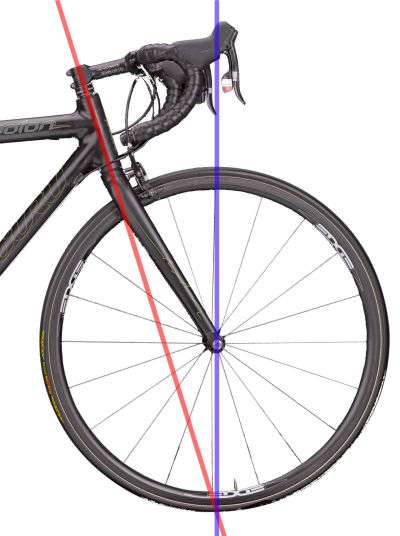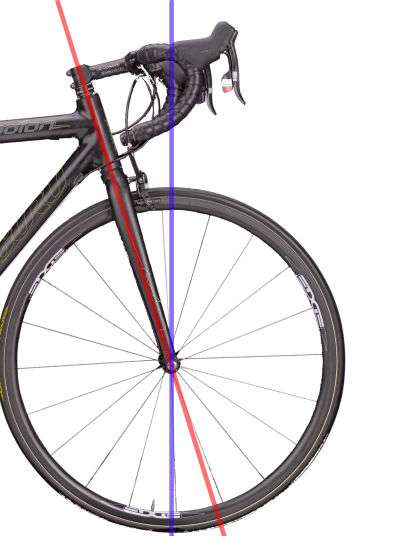Cross-winds and trail and Bicycle Quarterly, part 2
The description I gave last time was only part of the story described in Bicycle Quarterly and Tony Foale.
Suppose I'm riding along when a cross-wind strikes. It will apply a force to the rider, to the frame, to the rear wheel, and to the front wheel. The last time I dealt with the force as a whole, which causes the bike to lean, and the lean induces the front wheel to turn proportionate to the lean. But there's an additional factor. Okay, several, but there's only space to describe two of them in this post.
In the last analysis, I assumed a steady wind. But assume instead the wind strikes suddenly from the side. In this case, the bike is starting vertical: not leaned over. But the wind hits and suddenly it's pushing against the rider + bike. Without friction, the bike would accelerate sideways in response to this force, wheels and all. But there is friction: the tires grip the road, the and consistent with Newton's Third, the ground pushes back against the tire.
Now focus only on this reaction force. There's a lot of mass on the frame: it has a lot of inertia. The wheel, on the other hand, is relatively lighter. So as a first approximation we can consider the effect of this reaction force on the wheel orientation by assuming the frame position is fixed.
 Zero-trail bike
Zero-trail bike
Here I show a bike with zero trail: a hypothetical Guru Photon built with enough fork rake to put the contact point of the tire against the ground directly in line with the steering axis. It's easy to imagine that as the ground pushes against this contact patch it is unable to rotate the wheel. So the wind hits the rider exerting a force, that force is transferred to the ground, the ground pushes back, but that reaction force is unable to rotate the wheel and the bike generally continues pointing in the same direction.
 Zero-rake bike
Zero-rake bike
Now consider another extreme case: a bike with zero rake. Here the hub, not the contact point, is in line with the steering axis. As a result the contact patch falls well ahead of the steering axis. As the road pushes against the wheel, the wheel will rotate: wind flowing into the photo will tend to turn the wheel left (looking down). This will eventually cause the bike to fall into the wind.
But obviously this isn't all. A stationary bike balancing on two tires, hit with a gust of wind from the right, will fall to the left. The Bicycle Quarterly article doesn't discuss this component. The wind pushes the bike left, the tires provide a reaction force to the right (but lower down), and the resulting torque rotates the bike. This is the opposite of the effect from the wheel rotation.
So to cancel these two effects, so that the gust from the right pushes the bike to fall left but then the handlebars rotates to move the bike upright again, requires some trail. Zero trail and the bike would continue in a straight line but would tend to get blown over with the wind. Too much trail and the bike will change course too strongly when hit with the gust. So it's not a simple story of less trail is better in a cross-wind. The right amount of trail is needed, the optimum depending, among other factors, on the weight of the bike + rider and the height of the center-of-mass above the ground.
If the wind persists, however, and the rider needs to lean into the wind to compensate for the wind's force, then modest trail is probably desirable to reduce the force which must be maintained on the handlebars to keep the bike moving forward. Neither my Ritchey Breakaway nor my Fuji SL/1 is "low trail". The Ritchey is probably closer to the optimum for me if my perception that it handles better is valid.
Next time I'll look at the effect of the wind blowing against the wheel itself, another effect not described in the article.
Suppose I'm riding along when a cross-wind strikes. It will apply a force to the rider, to the frame, to the rear wheel, and to the front wheel. The last time I dealt with the force as a whole, which causes the bike to lean, and the lean induces the front wheel to turn proportionate to the lean. But there's an additional factor. Okay, several, but there's only space to describe two of them in this post.
In the last analysis, I assumed a steady wind. But assume instead the wind strikes suddenly from the side. In this case, the bike is starting vertical: not leaned over. But the wind hits and suddenly it's pushing against the rider + bike. Without friction, the bike would accelerate sideways in response to this force, wheels and all. But there is friction: the tires grip the road, the and consistent with Newton's Third, the ground pushes back against the tire.
Now focus only on this reaction force. There's a lot of mass on the frame: it has a lot of inertia. The wheel, on the other hand, is relatively lighter. So as a first approximation we can consider the effect of this reaction force on the wheel orientation by assuming the frame position is fixed.
 Zero-trail bike
Zero-trail bikeHere I show a bike with zero trail: a hypothetical Guru Photon built with enough fork rake to put the contact point of the tire against the ground directly in line with the steering axis. It's easy to imagine that as the ground pushes against this contact patch it is unable to rotate the wheel. So the wind hits the rider exerting a force, that force is transferred to the ground, the ground pushes back, but that reaction force is unable to rotate the wheel and the bike generally continues pointing in the same direction.
 Zero-rake bike
Zero-rake bikeNow consider another extreme case: a bike with zero rake. Here the hub, not the contact point, is in line with the steering axis. As a result the contact patch falls well ahead of the steering axis. As the road pushes against the wheel, the wheel will rotate: wind flowing into the photo will tend to turn the wheel left (looking down). This will eventually cause the bike to fall into the wind.
But obviously this isn't all. A stationary bike balancing on two tires, hit with a gust of wind from the right, will fall to the left. The Bicycle Quarterly article doesn't discuss this component. The wind pushes the bike left, the tires provide a reaction force to the right (but lower down), and the resulting torque rotates the bike. This is the opposite of the effect from the wheel rotation.
So to cancel these two effects, so that the gust from the right pushes the bike to fall left but then the handlebars rotates to move the bike upright again, requires some trail. Zero trail and the bike would continue in a straight line but would tend to get blown over with the wind. Too much trail and the bike will change course too strongly when hit with the gust. So it's not a simple story of less trail is better in a cross-wind. The right amount of trail is needed, the optimum depending, among other factors, on the weight of the bike + rider and the height of the center-of-mass above the ground.
If the wind persists, however, and the rider needs to lean into the wind to compensate for the wind's force, then modest trail is probably desirable to reduce the force which must be maintained on the handlebars to keep the bike moving forward. Neither my Ritchey Breakaway nor my Fuji SL/1 is "low trail". The Ritchey is probably closer to the optimum for me if my perception that it handles better is valid.
Next time I'll look at the effect of the wind blowing against the wheel itself, another effect not described in the article.
Comments